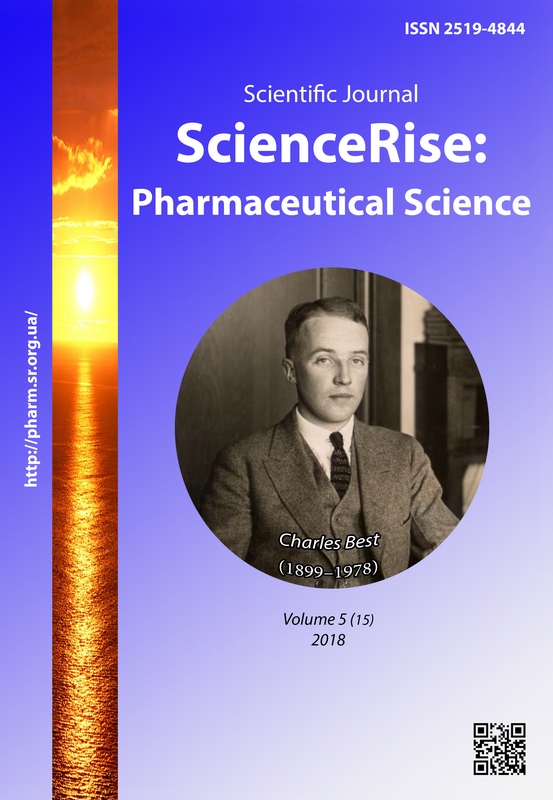Substantiation for the optimal strategy of risk management in marketing communicative activities of pharmaceutical enterprises based on mathematical model approach
DOI:
https://doi.org/10.15587/2519-4852.2018.146479Keywords:
risk factors, risk management strategies, marketing communicative activity, pharmaceutical enterprises, mathematical modelAbstract
Aim. To develop a mathematical model of risk analysis and evaluation in the marketing communication activity of pharmaceutical manufacturing enterprises in promoting a new medicine product under limiting and (or) saving investment funds for marketing communications. The obtained results allowed to make reasonable decisions as for choosing the optimal risk management strategy in marketing communication activities of pharmaceutical enterprises.
Methods. The implementation of the above tasks predetermined the choice of the following methods: content analysis, logical analysis, grouping and generalization, mathematical model methods, etc.
Results. The research resulted into introduction of the method of analysis and risk assessment in the marketing communication activity of pharmaceutical manufacturing enterprises in the promotion of a new medicine product using fuzzy modeling theory Fuzzy TECH.
The developed mathematical model allows the subjects of the pharmaceutical market to reasonably and timely evaluate the impact of certain risk factors on the results of the marketing communications program's implementation when promoting a new medicine product under limiting and (or) saving investment funds for marketing communications. Taking into account the obtained results allows to make a managerial decision on choosing an optimal risk management strategy in marketing communication activities of enterprises: risk avoidance, risk transfer, risk reduction, risk taking.
Conclusions. The given mathematical model is of practical value for the subjects of the pharmaceutical market, since it is not vulnerable to the number of input variables – higher or lower number of risk factors leads to higher or lower number of decision rules, with the model logic remaining unchanged
References
- Yevtushenko, O. M., Mnushko, Z. M. (2009). Risks of Commodity Promotion of New Medicine Product. Zaporozhye Medical Journal, 1 (52), 75–78.
- Samborskyi, O., Slobodyanyuk, M., Yevtushenko, O. (2017). There is a question of risk and management of vagueness processes in the field of pharmaceutical. The scientific heritage, 9 (9), 26–35.
- Gikher, Z. (2010). Practical experience of applying the risk management system in JSC InterChem. Pharmaceutical industry, 1 (18), 30–33.
- Lebedinets, V. O., Kovalenko, S. M. (2011). Assessment, analysis and risk management for quality in a pharmaceutical company. Management, economics and quality assurance in pharmacy, 6, 10–15.
- Lebedinets, V. O. (2012). Organization of internal risk-oriented audits of the pharmaceutical quality system. Management, economics and quality assurance in pharmacy, 2 (22), 21–26.
- Posilkina, O. V. (2002). Innovative and investment development of pharmaceutical production: problems of financial support. Kharkiv: NFaU: Golden Pages, 528.
- Rogachev, A. Yu. (2008). Enterprise risk management. Pharmaceutical company experience. Risk analysis problems, 4 (5), 30–38.
- Yakubovich, M. (2014). 4 risk management strategies obligatory for every project manager. Data portal «About business». Available at: https://probusiness.io/master_class/149-4-strategii-raboty-s-riskami-o-kotorykh-sleduet-znat-kazhdomu-rukovoditelyu-proekta.html Last accessed: 16/04/2018
- Kaplan, R. S., Mikes, A. (2012). Managing risks: a new framework. Harvard Business Review, 90.
- Froot, K. A., Scharfstein, D. S., Stein, J. C. (1994). A framework for risk management. Journal of Applied Corporate Finance, 7 (3), 22–33. doi: http://doi.org/10.1111/j.1745-6622.1994.tb00415.x
- Taplin, R. (Ed.) (2005). Risk management and innovation in Japan, Britain and United States. Abingdon: Routledge, 200. doi: http://doi.org/10.4324/9780203027783
- Frenkel, M., Hommel, U., Rudolf, M., Dufey, G. (2005). Risk management: challenge and opportunity. Berlin; New York: Springer, 236. doi: http://doi.org/10.1007/b138437
- Zaichenko, Yu. P. (2008). Fuzzy models and methods in intellectual systems. Kyiv: PH Word, 344.
- Pegat, A. (2013). Fuzzy modelling and management. Moscow: BINOM, Knowledge laboratory, 798.
- Yekhlakov, Yu. P., Permyakova, N. V. (2014). Decision-making algorithmic support for software projects risk management. Scientific herald of NSTU, 55 (2), 122–131.
- Yekhlakov, Yu. P., Permyakova, N. V. (2014). Fuzzy risk assessment model for software promotion. Business Computer Science, 3 (29), 69–78.
Downloads
Published
How to Cite
Issue
Section
License
Copyright (c) 2018 Anzhela Olkhovska, Volodymyr Malyi, Ihor Storozhenko

This work is licensed under a Creative Commons Attribution 4.0 International License.
Our journal abides by the Creative Commons CC BY copyright rights and permissions for open access journals.








